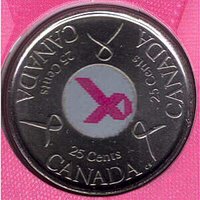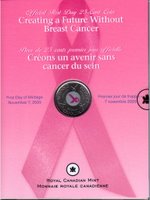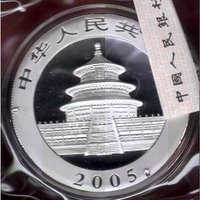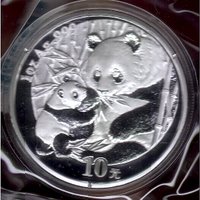Apr 29, 2006 | coins
It was a beautiful Friday afternoon in the nation’s capital, but I was stuck in the office. I was trying to finish a document for the client and was waiting for someone to review my work. Since my mind was on the sunny, wooded scene outside my office window, I did not want to start something new. I called up my browser and started to surf the Internet. I wanted to read anything that did not involve technology or the government. My attention turned to numismatics.
During my search, I stumbled across an article in The Columbus Dispatch that reported the auction sale of a rare, uncirculated 1792 half disme for $1.15 million ($1,322,500 with 15-percent buyer’s premium) to an anonymous collector. The auction was held at the Central States Numismatic Society (CSNS) 67th Annual Convention in Columbus, Ohio by Heritage Auctions Galleries.
 Although I am not a fan of the press these high-priced sales generate, I was intrigued by the date of this coin. If I remembered the history of the US Mint correctly, I thought the first half dismes were minted in 1794 following the first mintage of half cents and large cents in 1793. With a little time on my hands I started searching for more information. After trying unsuccessfully to find more information at my usual starting point, CoinFacts.com, I found the auction listing on the Heritage online catalog. [I found other sites that will be included in the Numismatic Links pages]
Although I am not a fan of the press these high-priced sales generate, I was intrigued by the date of this coin. If I remembered the history of the US Mint correctly, I thought the first half dismes were minted in 1794 following the first mintage of half cents and large cents in 1793. With a little time on my hands I started searching for more information. After trying unsuccessfully to find more information at my usual starting point, CoinFacts.com, I found the auction listing on the Heritage online catalog. [I found other sites that will be included in the Numismatic Links pages]
According to Heritage, the coin was graded SP67 (Specimen 67) by PCGS and “[d]espite opinions to the contrary, this issue is the first circulating American coin struck under authority of the Mint Act of April 1792.” I learned that 1,500-2,000 of these coins were minted for the new government by John Harper using the equivalent of $100 worth of silver reported to have been provided by George Washington. While there has been some controversy whether these were real or authorized coinage, the information in the Heritage listing provides strong evidence that these coins were accepted by Secretary of State Thomas Jefferson as legal tender.
In addition to the summary of the coin’s history, the listing also provides a list of 28 distinctive examples (plus some potential duplicates) of this coin from previous auctions or sales. This is why I love numismatics. The combination of history and the interesting designs makes the story of this coin a fascinating read. I hope the new collector enjoys this new prize!
Apr 23, 2006 | coins
![[Most Recent Quotes from www.kitco.com]](http://www.kitconet.com/charts/metals/silver/t24_ag_en_usoz_2.gif) With the spot price of silver hovering around $13 per ounce, it is getting more difficult to find silver bullion coins at lower prices. Up until the last month, I have been able to buy most silver bullion coins at the spot price or even a dollar lower on Ebay. This rise in silver prices has proven profitable for billionaire investors like Warren Buffet (The Wizard of Omaha) and Microsoft Chairman Bill Gates. Both invested in silver while at lower prices.
With the spot price of silver hovering around $13 per ounce, it is getting more difficult to find silver bullion coins at lower prices. Up until the last month, I have been able to buy most silver bullion coins at the spot price or even a dollar lower on Ebay. This rise in silver prices has proven profitable for billionaire investors like Warren Buffet (The Wizard of Omaha) and Microsoft Chairman Bill Gates. Both invested in silver while at lower prices.
Numismatically, I wrote that I liked silver bullion coins for being able to show off the coin’s design better than the “affordable” gold bullion coins. While looking at sets to purchase, I am drawn to the wonderful Adolph A. Weinman Walking Liberty design on the American Silver Eagle, the different design on the Great Britain Britannia Bullion Coin, the Chinese Silver Panda, and the simple yet elegant Canadian Maple Leaf. Over the last month I was able to procure at least one issue of all four of these coins at reasonable prices.
Bargains (and reasonable prices) in silver are becoming hard to find. Sources where I was able to buy at “fair” prices (± 10-percent of spot price) are now selling silver at premium prices (greater than 10-percent of spot price). Those bullion coins with greater numismatic value (e.g., uncirculated 1986 first year issue of the American Silver Eagle) are commanding prices beyond many price guides. I was a bit surprised to see the PCGS online price guide lists the 1993-P Proof American Silver Eagle for $190 at PR-65. My complete set of proof American Silver Eagles has been purchased from the US Mint at their issue. While they were bought as a collectible, the current market value of that collection is something to watch as the spot prices change!
One area where bargains cannot be found are with the silver Chinese Pandas. If you check the bargain basement capital of the world, Ebay, silver Pandas sell for an average of $8 more than American Silver Eagles. Are the Silver Pandas that popular? I had the chance to ask that question to Julian Leidman, noted dealer, who was speaking at the recent meeting of the Montgomery County Coin Club. Mr. Leidman said that the Silver Pandas are sold at a premium by the Chinese government. He said that the Pandas have become a very popular collectible worldwide and that the Chinese government was capitalizing on that popularity.
The silver market is getting very interesting. It may not reach the highs seen in 1980 (over $300 per ounce), but the demands and the investors using silver as part of their portfolio make it very interesting to watch.
Apr 16, 2006 | coins, foreign
Over the last few years, the trade press has run articles about the uninspired designs of US coinage. The 50 State Quarters Program has seen reviews from fantastic (the Charter Oak of Connecticut) to scary (the hanging astronaut of Ohio). Recent portraits of Thomas Jefferson on the Return to Monticello nickel and Benjamin Franklin on the commemorative celebrating his 300th birthday are so bad that they are barely a representation of the person being honored.
 One country that does a great job with its coinage is Canada. Since I started collecting Canadian coins two years ago, I have been studying their significance and admiring their designs. Recently, the Royal Canadian Mint (RCM) issued the 2006 25-Cent Circulation Coin Creating a Future Without Breast Cancer. The coin’s reverse features an enameled pink ribbon in the center surrounded by the engraving. The obverse is the common design featuring HM Queen Elizabeth II. It is a simple and elegant design that is well executed by RCM. This campaign puts 30 million coins into circulation to support the work of the Canadian Breast Cancer Foundation.
One country that does a great job with its coinage is Canada. Since I started collecting Canadian coins two years ago, I have been studying their significance and admiring their designs. Recently, the Royal Canadian Mint (RCM) issued the 2006 25-Cent Circulation Coin Creating a Future Without Breast Cancer. The coin’s reverse features an enameled pink ribbon in the center surrounded by the engraving. The obverse is the common design featuring HM Queen Elizabeth II. It is a simple and elegant design that is well executed by RCM. This campaign puts 30 million coins into circulation to support the work of the Canadian Breast Cancer Foundation.
RCM sells this coin in several collectible forms. My purchase included the first day of mintage card. This card is tri-folded with the coin encapsulated in the center. Inside, it explains the campaign, the hope for a future without breast cancer, and that part of the proceeds will go to the Canadian Breast Cancer Foundation to support their programs. It is a beautiful collectible in support a worthy cause.
 I also purchased the 2006 CAN$5 Special Edition Proof with the pink enameled ribbon on the reverse. According to the RCM website, “Its inspiring design reveals the many fronts working to create a future without breast cancer. A special “enamel-effect” combined with pure silver creates a powerful statement of hope that will enrich any collection.” When I received the coin, my reaction was “oh wow!” It is beautiful, well executed, and a true inspiration to the cause.
I also purchased the 2006 CAN$5 Special Edition Proof with the pink enameled ribbon on the reverse. According to the RCM website, “Its inspiring design reveals the many fronts working to create a future without breast cancer. A special “enamel-effect” combined with pure silver creates a powerful statement of hope that will enrich any collection.” When I received the coin, my reaction was “oh wow!” It is beautiful, well executed, and a true inspiration to the cause.
 In my last two years of starting a Canadian coin collection, I have seen the RCM issue beautiful coins on a variety of topics. Although I do not yet know the process the RCM has to undergo for permission to produce these coins, it is obviously not the politically charged process that the US Mint has been tied to for over 200 years. I will investigate the Canadian process and compare it with what we have to go through in the US to see why Canada seems to issue more inspiring coins.
In my last two years of starting a Canadian coin collection, I have seen the RCM issue beautiful coins on a variety of topics. Although I do not yet know the process the RCM has to undergo for permission to produce these coins, it is obviously not the politically charged process that the US Mint has been tied to for over 200 years. I will investigate the Canadian process and compare it with what we have to go through in the US to see why Canada seems to issue more inspiring coins.
Apr 11, 2006 | coins, foreign
With the precious metals market on the rise, many collectors and investors have been purchasing bullion and rare coins. One segment that is appealing to many investors and collectors are silver bullion coins.
If you are a reader of Numismatic News, you would have been reading a flurry or articles about the use of base metals over precious metals for our coinage. While both sides have their points, the fact remains that the base metal coins are legal tender and used in our daily transaction. But the appeal of precious metals was not lost on the US Mint when they create the American Eagle Bullion Coins. Since then, the awareness of collecting bullion coins has grown.
As a collector, I like different types of coins. I was first drawn to the Silver American Eagles when my father started buying the proof coins for me. He has done this every year since 1986. I find the silver coins appealing for their look and feel. Not only are they a great collectibles, but their silver price has increased over the years. That is one of the reasons why I have been buying and hoarding uncirculated Eagles when I can find them at a good price.
Since then, I have started to collecting Canadian Silver Maple Leaf bullion coins. For a simple coin, they have a beauty that I find intriguing. Canada has been producing the Silver Maple Leaf since 1988 and I am working on putting together a complete set.
While hunting for nice examples of American Silver Eagle and Silver Maple Leaf coins, I found the Chinese Silver Panda. As I started to look into the Panda, I found that except for 1991 and 1992, all the reverse designs are different and the same design is used on both the silver and gold coins.
I have found some nice, inexpensive gold Pandas through Internet auctions, but when I saw the silver Pandas I was excited. Not because they are more affordable than even the gold 1/20 oz. 20 Yuan Panda, but 10 Yuan 1 ounce silver Panda allows them to show the design on a 40mm diameter planchet of silver as compared to the 14mm diameter of gold. It is amazing what an extra 26mm of surface can do for a design.
 I recently bought my first two Silver Pandas in mint packaging from an Internet auction site. The common obverse has Chinese letters which is the title of the People’s Republic of China, the year of issue, and a wonderful proof-like engraving of Hall of Prayer for Good Harvests of the Temple of Heaven in Beijing. (click photo to enlarge)
I recently bought my first two Silver Pandas in mint packaging from an Internet auction site. The common obverse has Chinese letters which is the title of the People’s Republic of China, the year of issue, and a wonderful proof-like engraving of Hall of Prayer for Good Harvests of the Temple of Heaven in Beijing. (click photo to enlarge)  The reverse of the 2003 coin shows a single panda walking on all four legs through a bamboo forest. Although the China Gold Coin provides images of the coin, the real coin is more beautiful.
The reverse of the 2003 coin shows a single panda walking on all four legs through a bamboo forest. Although the China Gold Coin provides images of the coin, the real coin is more beautiful.
 The 2005 Panda design features a mother panda feeding her cub in a bamboo forest. Although I do have a 1/20 oz gold coin of this design, the 40mm silver Panda is well executed and beautiful. The extra room for the design works very well with this design allowing the coin to pass the eye appeal test.
The 2005 Panda design features a mother panda feeding her cub in a bamboo forest. Although I do have a 1/20 oz gold coin of this design, the 40mm silver Panda is well executed and beautiful. The extra room for the design works very well with this design allowing the coin to pass the eye appeal test.
I will be adding more Pandas to my collection. They deserve their place next to my collection of American Silver Eagle, Canadian Maple Leaf, and British Britannia coins. It will be a beautiful collection once it is completed.
Apr 8, 2006 | BEP, coins, currency
Money has always been a fascination because of their design and the history they reveal. It is interesting to look at a series of the same denomination and learn the history behind the designs. I had the chance to do that when my bank’s ATM gave me three generations of $20 Federal Reserve Notes (FRN). Although I am not a bank note collector, I find their images and devices interesting.
 First, I found is the Series 1990 note with the signature of Treasury Secretary Nicholas F. Brady and Catalina Vasquez Villalpando, the Treasurer of the United States. Both Brady and Villalpando were appointed by President George H. W. Bush and served until the end of his term. Brady also served for six months under President Ronald W. Reagan.
First, I found is the Series 1990 note with the signature of Treasury Secretary Nicholas F. Brady and Catalina Vasquez Villalpando, the Treasurer of the United States. Both Brady and Villalpando were appointed by President George H. W. Bush and served until the end of his term. Brady also served for six months under President Ronald W. Reagan.
The second is a Series 2001 note with the signatures of Treasury Secretary Paul M. O’Neill and Treasurer Rosario Marin. They were appointed by President George W. Bush during his first term. The third note is from Series 2004 with Marin’s signature along with Treasury Secretary John W. Snow, who succeeded O’Neill.
 My first impression was the differences in design. The $20 FRN was first designed in the 1920s and was an evolution of earlier designs. It has ornate and fine engraving with a green hue. The fine engraving has been a staple of bank notes since their inception as a means to prevent counterfeiting. The “green back” was used to prevent copying using new photographic technologies which had a difficult time reproducing the green color. Today, the green color remains out of tradition considering modern imaging capabilities.
My first impression was the differences in design. The $20 FRN was first designed in the 1920s and was an evolution of earlier designs. It has ornate and fine engraving with a green hue. The fine engraving has been a staple of bank notes since their inception as a means to prevent counterfeiting. The “green back” was used to prevent copying using new photographic technologies which had a difficult time reproducing the green color. Today, the green color remains out of tradition considering modern imaging capabilities.
The newer notes do not have a lot of fine engraving. The same portrait of President Andrew Jackson is used but was enlarged on the newer notes with the border around the portrait removed on the Series 2004 notes. Another difference is the addition of color with a darker green hue and peach on the front adds a new dimension I am not sure I like.
Although an engraving of the White House remain on the reverse, the older note uses an image taking from the south lawn from the ellipse. The new notes show the White House from the north lawn that could be seen from Pennsylvania Avenue more centered rather than filling the entire reverse. As part of the Bureau Engraving and Printing’s (BEP) program to include better security features, they have left the sides blank so the watermark image and security thread can be easily seen.
I like the front of the latest note, but I don’t like the color. I also miss the indication of the Federal Reserve System Bank for which the notes were printed. It is like the mint mark for the FRN. I always found it interesting finding notes from different areas. I like the south lawn portrait better than the one from the north lawn. I am disappointed with the starkness of the reverse. I am not sure that BEP can change this given the nature of the security features.
Finally, the attempt to colorize the notes is not working. It looks cheesy. If BEP colorizes the note, it should be more than just a gradient on the background. Many countries use color in their bank notes as part of the devices, not just to splash some color around to say “look at the color.” I think BEP can do better.
Apr 7, 2006 | coins
After a few days of nice finds, real life set in leaving me very busy with my day job and trying to complete my taxes. Tax season is not one of my favorite times and I am sure it does not rank high on your list.
Since the postings of my finds, I withdrew money from my bank’s ATM and found the last three types of $20 Federal Reserve notes. I will write more about this over the weekend, but seeing the transition of the design is very interesting.
Other future entries will include a word or two about two new purchases: silver Chinese Pandas and the Breast Cancer 25-cent circulating commemorative from the Royal Canadian Mint. The Pandas are very interesting and worthy of a look. As for the Breast Cancer Commemorative, I am an advocate for any program that raises money and awareness for cancer research. Stay tuned!
 Although I am not a fan of the press these high-priced sales generate, I was intrigued by the date of this coin. If I remembered the history of the US Mint correctly, I thought the first half dismes were minted in 1794 following the first mintage of half cents and large cents in 1793. With a little time on my hands I started searching for more information. After trying unsuccessfully to find more information at my usual starting point, CoinFacts.com, I found the auction listing on the Heritage online catalog. [I found other sites that will be included in the Numismatic Links pages]
Although I am not a fan of the press these high-priced sales generate, I was intrigued by the date of this coin. If I remembered the history of the US Mint correctly, I thought the first half dismes were minted in 1794 following the first mintage of half cents and large cents in 1793. With a little time on my hands I started searching for more information. After trying unsuccessfully to find more information at my usual starting point, CoinFacts.com, I found the auction listing on the Heritage online catalog. [I found other sites that will be included in the Numismatic Links pages]![[Most Recent Quotes from www.kitco.com]](http://www.kitconet.com/charts/metals/silver/t24_ag_en_usoz_2.gif)









